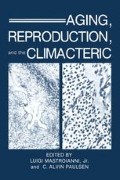Abstract
How much does the capacity to reproduce decline with age? Until quite recently, it was believed that fecundity declined slightly from age 20 to the early thirties, but more sharply after 35. Then a French study (Federation CECOS, 1982) published in February, 1982, reported results from a group of women who had undergone artificial insemination (Table I). Approximately 74% of women who were not over 30 conceived within 12 menstrual cycles. The percentage fell to only 62 for women 31–35, and to 56 for women 36–40. An accompanying editorial and many later newspaper and magazine articles suggested that risks of infertility rose sharply starting as early as age 30. The purpose of this chapter is to review evidence of the level and age pattern of decline in fecundity for women and for men and then to focus on delayed childbearing.
Access this chapter
Tax calculation will be finalised at checkout
Purchases are for personal use only
Preview
Unable to display preview. Download preview PDF.
References
Bongaarts, J., 1982, Infertility after age 30: A false alarm, Fam. Plann. Perspect. 14(2):75–78.
Coale, A., and Trussell, J., 1974, Model fertility schedules: Variation in the age structure of childbearing in human populations, Popul. Index 40:185–201.
Collins, J. A., Wrixon, W., Janes, L. B., and Wilson, E. H., 1983, Treatment-independent pregnancy among infertile couples, New Engl. J. Med. 309:1201–1206.
Curran, J. W., 1980, Economic consequences of pelvic inflammatory disease in the United States, Am. J. Obstet. Gynecol. 138 (7, Part 2): 848–851.
Eighth Census of Canada, 1946, Vol. 3, Ages of the population, Ottawa.
Federation CECOS, Schwartz, D., and Mayaux, H. J., 1982, Female fecundity as a function of age, New Engl. J. Med. 307:404–406.
Flinn, M., 1981, The European Demographic System, 1500–1820, The Johns Hopkins University Press, Baltimore.
Hajnal, J., 1965, European marriage patterns in perspective, in: Population in History (D.V. Glass and D.E.C. Eversley, eds.), Edward Arnold, London.
Hendershot, G. E., Mosher, W. D., and Pratt, W. F., 1982, Infertiltiy and age: An unresolved issue, Fam. Plann. Perspect. 14(5):287–290.
Henry, L., 1961, Some data on natural fertility, Eugenics Q. 8:81–91.
Heuser, R. L., 1976, Fertility tables for birth cohorts by color, DHEW publication No. (HRA) 76-1152, U.S. Government Printing Office, Washington, D.C.
Hogue, C. J. R., Cates, W., and Tietze, C., 1982, The effects of induced abortion on subsequent reproduction, Epidemiol. Rev. 4:66–71.
Hogue, C. J. R., Cates, W. and Tietze, C., 1983, Impact of vacuum aspiration abortion on future childbearing: A review, Fam. Plann. Perspect. 15:119–126.
[Ireland], Great Britain Parliament House of Commons, 1913, Parliamentary papers, accounts and papers, Vol. 118, 1912-1913. “Census of Ireland, 1911. General report, with tables and appendix.” H.M. Stationary Office, London.
McFalls, J., 1979, Frustrated Fertility: A Population Paradox, Popul. Bull. 34, No. 2.
Menken, J., and Larsen, U., 1984, Age and fertility: How late can you wait? Paper presented at the annual meeting of the Population Association of America; 1984 May, 3-5; Minneapolis, Minnesota.
Mineau, G., and J. Trussell, 1982, A specification of marital fertility by parents’ age, age at marriage, and marital duration, Demography 19(3):335–350.
Mosher, W. D., 1982, Infertility trends among U.S. couples: 1965–1976, Fam. Plann. Perspect. 14(1):22–27.
Mosher, W. D., and Pratt, W. F., 1982, Reproductive impairments among married couples, United States, Vital and Health Statistics. Series 23, No. 11. National Center for Health Statistics. U.S. Government Printing Office, Washington.
National Center for Health Statistics, December, 1983a, Advance report of final natality statistics, 1981, Monthly Vital Statistics Report, Vol. 32, No. 9.
National Center for Health Statistics, 1983b, Unpublished data.
Page, H., 1977, Patterns underlying fertility schedules: A decomposition by both age and marriage duration, Popul. Stud. 31:85–106.
[Scotland], Great Britain, Parliament House of Commons, 1914, Parliamentary papers, accounts and papers, Vol. 44, 1914. Census of Scotland, 1911. Report on the Twelfth Decennial Census of Scotland. H.M. Stationery Office: London.
Senanayake, P., and Kramer, D. G., 1980, Contraception and the etiology of pelvic inflammatory disease: New perspectives, Am. J. Obstet. Gynecol. 138(7, Part 2):852–860.
Trussell, J., and Wilson, C., 1985, Sterility in a population with natural fertility, Popul. Stud. 39: 269–286.
Tukey, J. W., 1977, Exploratory Data Analysis, Addison-Wesley, Reading.
Ventura, S., 1982, Trends in first births to older mothers, 1970-79, National Center for Health Statistics, Monthly Vital Statistics Report, Vol. 31, No. 2 Supp. (2).
Vessey, M. P., Wright, N. H., McPherson, K. and Wiggens, P., 1978, Fertility after stopping different methods of contraception, Br. Med. J. 1(4 Feb.):265–267.
Vital Statistics of the United States, 1976, Vol. 1, Natality, Hyattsville, Maryland, NCHS, 1980.
Weström, L., 1980, Incidence, prevalence and trends of acute pelvic inflammatory disease and its consequences in industrialized countries. Am. J. Obstet. Gynecol. 138(7, Part 2):880–892.
Author information
Authors and Affiliations
Editor information
Editors and Affiliations
Rights and permissions
Copyright information
© 1986 Plenum Press, New York
About this chapter
Cite this chapter
Menken, J., Larsen, U. (1986). Fertility Rates and Aging. In: Mastroianni, L., Paulsen, C.A. (eds) Aging, Reproduction, and the Climacteric. Springer, Boston, MA. https://doi.org/10.1007/978-1-4684-5047-7_9
Download citation
DOI: https://doi.org/10.1007/978-1-4684-5047-7_9
Publisher Name: Springer, Boston, MA
Print ISBN: 978-1-4684-5049-1
Online ISBN: 978-1-4684-5047-7
eBook Packages: Springer Book Archive

